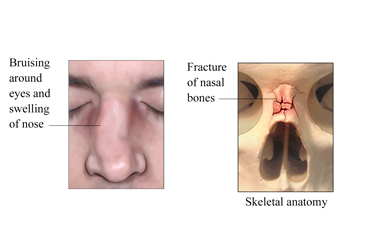Broken Nose: Care Instructions
Overview

A broken nose is a break, or fracture, of the bone or cartilage. Most broken noses need only home care and a
follow-up visit with a doctor. The swelling should go down in a few days. Bruises around your eyes and nose
should go away in 2 to 3 weeks.
You heal best when you take good care of yourself. Eat a variety of healthy foods, and don't smoke.
Follow-up care is a key part of your treatment and safety. Be sure to make and go to all
appointments, and call your doctor if you are having problems. It's also a good idea to know your test results
and keep a list of the medicines you take.
How can you care for yourself at home?
-
If you have a nasal splint or packing, leave it in place until a doctor removes it.
-
If your doctor prescribed antibiotics, take them as directed. Do not stop taking them just because you
feel better. You need to take the full course of antibiotics.
-
Take decongestants as directed to help you breathe after the splint or packing is removed. Your doctor may
give you a prescription or suggest over-the-counter medicine.
-
Be safe with medicines. Take pain medicines exactly as directed.
-
If the doctor gave you a prescription medicine for pain, take it as prescribed.
-
If you are not taking a prescription pain medicine, ask your doctor if you can take an
over-the-counter medicine.
-
Put ice or a cold pack on your nose for 10 to 20 minutes at a time. Try to do this every 1 to 2 hours for
the first 3 days (when you are awake) or until the swelling goes down. Put a thin cloth between the ice pack
and your skin.
-
Sleep with your head slightly raised until the swelling goes down. Prop up your head and shoulders on
pillows.
-
Ask your doctor when it's okay to return to your normal activities.
When should you call for help?
 Call 911
anytime you think you may need emergency care. For example, call if:
Call 911
anytime you think you may need emergency care. For example, call if:
Call your doctor now or seek immediate medical care if:
Watch closely for changes in your health, and be sure to contact your doctor if:
Current as of: July 10, 2023
Content Version: 14.0
Care instructions adapted under license by your
healthcare professional. If you have questions about a medical condition or this instruction, always ask
your healthcare professional. Healthwise, Incorporated disclaims any warranty or liability for your use of
this information.